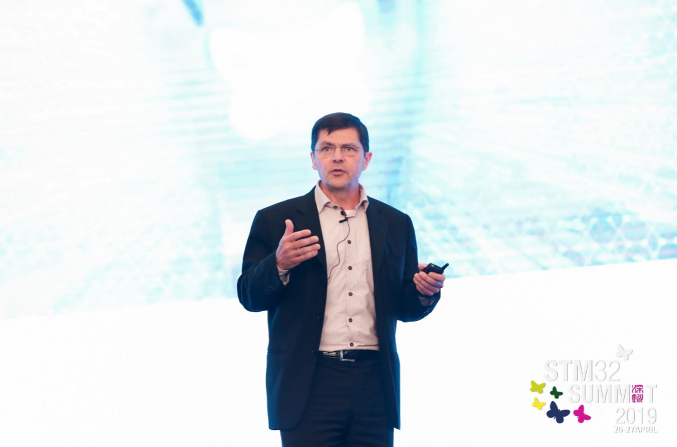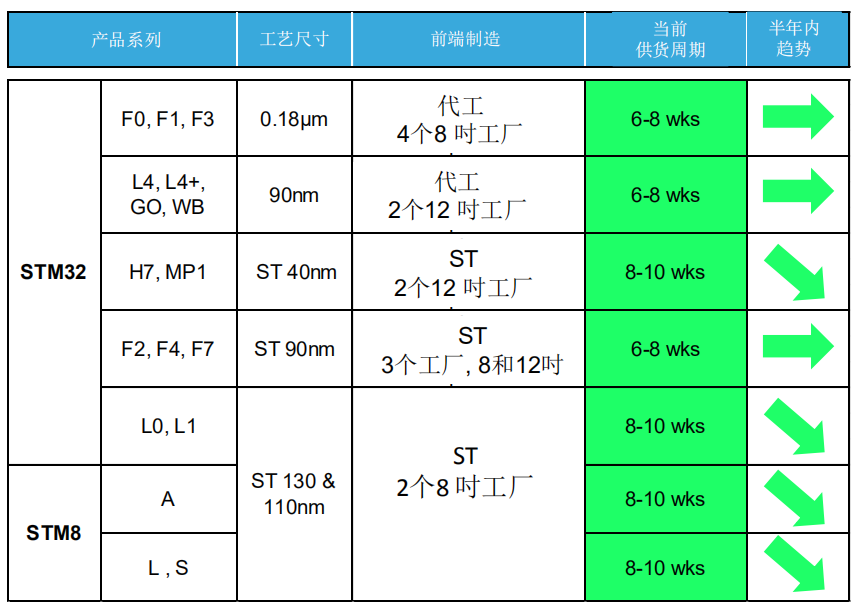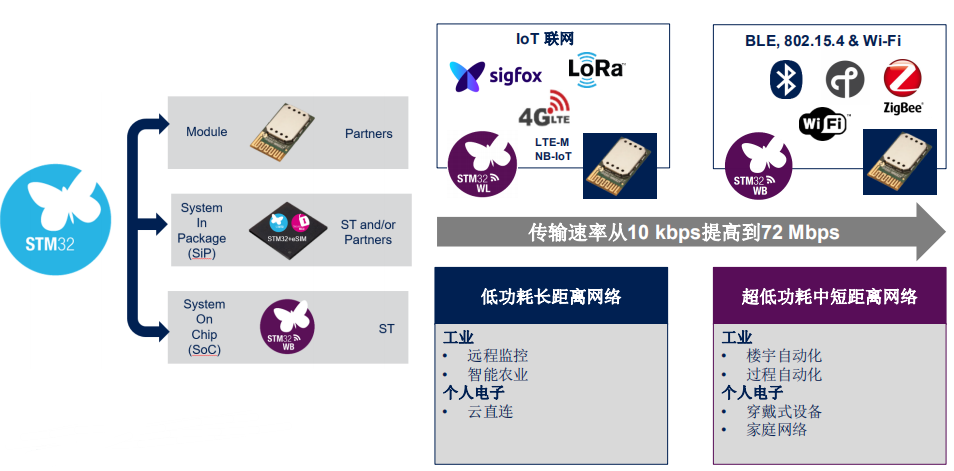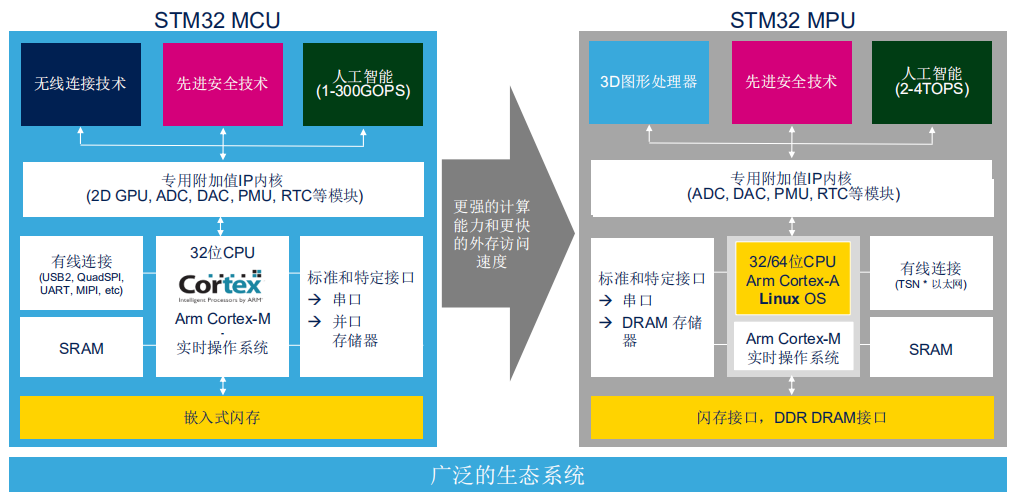Recently, Ricardo De-Sa-Earp, Vice President of STMicroelectronics' Microcontroller and Digital IC (MDG) Product Division and General Manager of the Microcontroller Business Unit, took the opportunity of the STM32 Summit to introduce the future plans and development prospects of STM32 to the Chinese market.

Ricardo De-Sa-Earp, Vice President of Microcontroller and Digital ICs (MDG) Division and General Manager of Microcontroller Business Unit, STMicroelectronics
Ricardo said that the strategy of ST's microcontroller division can be simply described in two words: innovation. From 8-bit MCU to 32-bit different combinations, MCUs with different characteristics to MPUs, ST continues to innovate and add many differentiated options to MCUs. At the same time, in order to expand the MCU ecosystem, ST has successively acquired a number of software development companies to provide customers with a better one-stop experience.
"These strategies have been successfully implemented and recognized by customers. We first launched STM32 in 2007, ranking 11th in the market. By 2015, the market ranking jumped to third, and last year it reached second place. At the same time, our general MCU market in China ranks first." In
2018, STMicroelectronics shipped more than 1.2 billion MCUs, with an annual compound growth rate of more than 30%. This is bound to be a test for the supply chain. For this reason, STMicroelectronics has provided a ten-year supply commitment and dual-wafer fab production to ensure safe and stable production capacity. To this day, all STM32 13 series products are still in mass production, including 180nm process products 10 years ago.

Flexible factory layout for STMicroelectronics MCU product line
Connectivity, artificial intelligence and security
Ricardo said that security, artificial intelligence and connectivity are the three major development paths of STM32 in the future, and STM32MP1 represents another high-performance route.
Full connectivity solution
Ricardo defines the STM32 connectivity solution as a full solution, which can be viewed from multiple angles. First of all, in terms of product form, ST and its partners have developed a variety of styles such as modules, SiP and SoC to meet different market needs. In terms of supported standards, it includes low-power and long-distance Lora, Sigfox, LTE, NB-IoT and other standards, as well as medium and short-distance products such as BLE, WiFi, and Bluetooth. There are products that meet both industrial industry standards and personal electronic standards.

All In Artificial Intelligence
Ricardo said that STM32 expands computing power by constantly introducing new elements. For example, 3D graphics accelerators and artificial intelligence elements, as well as the latest memory interfaces, STM32MP1 have achieved a great expansion of computing power. "So far, we have implemented 32-bit Linux in Cortex-A and real-time operating systems in the Cortex-M series." Ricardo said.
In the field of artificial intelligence, in addition to the MP1 TFLOPS processing performance, STMicroelectronics has also developed artificial intelligence for MCUs with lower processing performance. Although the processing power is several hundred GFLOPS, it can achieve functions such as step recognition and scene recognition. "We are now focusing on edge artificial intelligence. We firmly believe that smart connected terminals must have artificial intelligence capabilities and ultra-low power consumption, so as to ensure the most efficient data transmission on the node."
However, for embedded terminals, neural networks are not easy to import into MCUs due to problems such as computing power and operating system. To this end, ST has developed a functional software package Cube.AI, which uses an artificial intelligence framework to map neural networks to STM32, which is relatively convenient and allows more developers to deploy edge artificial intelligence with ease.
Currently, the software package already supports audio and motion analysis, character recognition and image classification, as well as more follow-up development functions. At the same time, ST has also launched a partner AI special program that can provide neural network engineering services to ensure a better user experience.

Security is fundamental.
Ricardo emphasized that all microcontrollers currently have built-in and inherited security technologies, such as security authentication solutions, secure memory, code and data isolation, etc. In
2018, ST also released the Cortex-M33 processor STM32L5 with integrated Arm TrustZone hardware security technology, which has flexible software isolation, secure boot, key storage and hardware encryption accelerator functions. In addition, ST also has a dedicated security MCU business unit.
Software is indispensable.
Ricardo finally introduced the rich and colorful prototyping, development tools and software components of STM32. For example, in 2018, it announced the acquisition of Draupner Graphics, the developer and supplier of TouchGFX software, to provide customers with more flexible embedded solutions. "Now we have successfully introduced factors such as graphical interfaces and cloud connections to microcontrollers, giving embedded systems more flexible functions." Ricardo said.
According to Ricardo, the total number of STM32 customers has reached more than 60,000. Such a large customer base must be dealt with by a complete ecosystem. This is the biggest innovation of STM32 - building a huge, complex and clearly divided ecosystem in the MCU and embedded fields.
Previous article:Win-win cooperation and co-building of the ecosystem are the DNA of STM32
Next article:The father of STM32 talks about the 2019 product roadmap: cost-effectiveness, AI, and development experience
Recommended ReadingLatest update time:2024-11-16 11:32



- Popular Resources
- Popular amplifiers
-
 Wireless Sensor Network Technology and Applications (Edited by Mou Si, Yin Hong, and Su Xing)
Wireless Sensor Network Technology and Applications (Edited by Mou Si, Yin Hong, and Su Xing) -
 Modern Electronic Technology Training Course (Edited by Yao Youfeng)
Modern Electronic Technology Training Course (Edited by Yao Youfeng) -
 Modern arc welding power supply and its control
Modern arc welding power supply and its control -
 Small AC Servo Motor Control Circuit Design (by Masaru Ishijima; translated by Xue Liang and Zhu Jianjun, by Masaru Ishijima, Xue Liang, and Zhu Jianjun)
Small AC Servo Motor Control Circuit Design (by Masaru Ishijima; translated by Xue Liang and Zhu Jianjun, by Masaru Ishijima, Xue Liang, and Zhu Jianjun)
 Professor at Beihang University, dedicated to promoting microcontrollers and embedded systems for over 20 years.
Professor at Beihang University, dedicated to promoting microcontrollers and embedded systems for over 20 years.
- Innolux's intelligent steer-by-wire solution makes cars smarter and safer
- 8051 MCU - Parity Check
- How to efficiently balance the sensitivity of tactile sensing interfaces
- What should I do if the servo motor shakes? What causes the servo motor to shake quickly?
- 【Brushless Motor】Analysis of three-phase BLDC motor and sharing of two popular development boards
- Midea Industrial Technology's subsidiaries Clou Electronics and Hekang New Energy jointly appeared at the Munich Battery Energy Storage Exhibition and Solar Energy Exhibition
- Guoxin Sichen | Application of ferroelectric memory PB85RS2MC in power battery management, with a capacity of 2M
- Analysis of common faults of frequency converter
- In a head-on competition with Qualcomm, what kind of cockpit products has Intel come up with?
- Dalian Rongke's all-vanadium liquid flow battery energy storage equipment industrialization project has entered the sprint stage before production
- Allegro MicroSystems Introduces Advanced Magnetic and Inductive Position Sensing Solutions at Electronica 2024
- Car key in the left hand, liveness detection radar in the right hand, UWB is imperative for cars!
- After a decade of rapid development, domestic CIS has entered the market
- Aegis Dagger Battery + Thor EM-i Super Hybrid, Geely New Energy has thrown out two "king bombs"
- A brief discussion on functional safety - fault, error, and failure
- In the smart car 2.0 cycle, these core industry chains are facing major opportunities!
- The United States and Japan are developing new batteries. CATL faces challenges? How should China's new energy battery industry respond?
- Murata launches high-precision 6-axis inertial sensor for automobiles
- Ford patents pre-charge alarm to help save costs and respond to emergencies
- New real-time microcontroller system from Texas Instruments enables smarter processing in automotive and industrial applications
- Allwinner heterogeneous multi-core AI intelligent vision V853 development board evaluation - v853 YOLO v5 quantization -> installation of yoloV5
- [ST NUCLEO-U575ZI-Q Review] + Multi-channel ADC data acquisition
- Today's live broadcast: TI Matter solutions help smart home innovation
- Years of points exchanged for a watch
- e-Network Limited Time Benefits|"e-Select"-------Show Order
- Please advise on capacitor charging and discharging and parallel capacitor problems
- [ ST NUCLEO-U575ZI-Q Review] Share GPDMA information
- Raspberry Pi Official Manual 2023
- [Pingtouge Boliu BL606P audio and video development board] Unboxing and setting up the development environment HelloWorld
- TI enters the M0 MCU camp. What is it up to?

 Wireless Sensor Network Technology and Applications (Edited by Mou Si, Yin Hong, and Su Xing)
Wireless Sensor Network Technology and Applications (Edited by Mou Si, Yin Hong, and Su Xing)
















 京公网安备 11010802033920号
京公网安备 11010802033920号